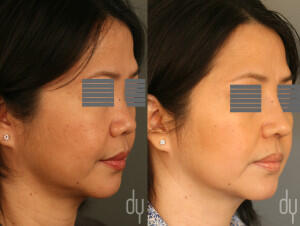Common goals in Asian rhinoplasty include augmenting the dorsum (building the bridge), projecting and refining the tip (making the tip smaller and taller), and narrowing the nose. A variety of different techniques have been described to augment the dorsum, including using synthetic materials such as silicone or Gore-tex, and using autologous materials (from your own body) such as rib cartilage and diced cartilage wrapped in fascia (DCF).
Figure. 1
Silicone nasal implants have become a popular choice for dorsal augmentation because they are pre-formed in a variety of different shapes and sizes and are easy to place, thus greatly reducing operating time and complexity. Immediate results are also quite good, especially in patients with thicker skin such as Asians. Although Asian rhinoplasty with silastic implants is quicker and easier than surgery with autologous grafts (your own tissue), it does come with a number of downsides. Silicone implants never become incorporated into your nose and always remains as a foreign body. Thus, there is always a risk of migration, infection and extrusion. Even if an implant has been safely in place for ten years, there is still a chance for the implant to move out of position, or even thin out the skin to the point of poking through the skin (see Figure 1).
Dorsal augmentation with autologous grafts is a more technically challenging and far more time consuming surgery, but the results are natural, safer and permanent. Beverly Hills facial plastic surgeon Dr. Donald Yoo specializes in Asian rhinoplasty using autologous grafts because it provides the best possible aesthetic and functional outcomes. He is amongst a small, elite group of surgeons worldwide with extensive experience in using rib cartilage for Asian rhinoplasty. Instead of using a pre-formed silicone implant, harvested rib cartilage is finely diced and wrapped in fascia harvested from a hidden incision in the hairline (see Figure 2). This implant is custom tailored to provide the precise augmentation and bridge shape desired.
Figure. 2 Removed silicone implant. Below: Custom-made diced-cartilage fascia (DCF) implant.
Unlike the silicone implants, diced-cartilage fascia (DCF) implants become fully incorporated into your nose so that it simply becomes a part of you. In addition, the DCF provides a very natural, aesthetically pleasing contour, unlike the very sharp and artificial edges of silicone implants. The result is a more beautiful you.

Before and After augmentation Asian rhinoplasty with DCF (diced cartilage fascia) and rib cartilage harvest.


 Contact Us
Contact Us